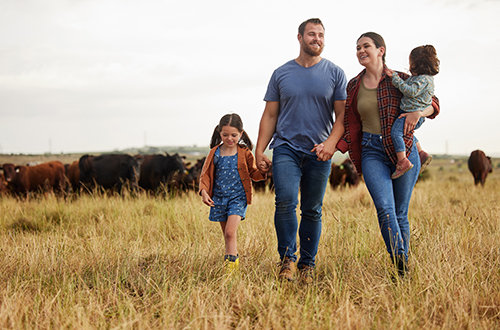Scrapping the Pension Lifetime Allowance: the impact on farmers’ pension contributions
In the March 2023 Budget , the Chancellor announced measures relating to pensions tax limits including a scrapping of the Pension Lifetime Allowance (LTA) from 6 April 2023.
The LTA was a cap (set at circa £1.07m per individual for the tax year 2022-23) on the amount of pension savings that could be accumulated tax free, and a tax charge arose on any excess funds when pension was taken. This tax charge was either 55%, if the excess was withdrawn as a lump sum, or 25% if the balance was left in the fund (but the remainder would then be subject to Income Tax at the recipient’s marginal Income Tax rate when drawn).
Very broadly the LTA charge would apply at the age of 75 or on another “Benefits Crystallisation Event” (BCE), the definitions of which are outside the scope of this article.
Alongside the LTA announcement, there was also an increase in the pension annual allowance, the maximum amount that can be saved in a pension that qualifies for tax relief each year.
From 6 April 2023, this increased from £40,000 to £60,000, and the increase is coupled with a rise in the adjusted income level from £240,000 to £260,000 over which the allowance begins to taper away (reducing by £1 for every £2 of taxable income above that threshold, up to £360,000 of income where the minimum annual allowance of £10,000 applies).
How do these new rules affect farmers?
Generally speaking, most farming businesses are set up in the form of partnerships. As a result of this, like sole traders, partners are self-employed and as a result cannot make employer pension contributions for themselves.
Partners receive tax relief on their own pension contributions using the Relief at Source (RAS) system. Under the RAS rules, payments to a pension scheme are made net of 20% tax. For example, if an individual wanted £1,000 to go into their pension fund, they would need to pay £800 and HMRC would make up the difference of £200.
In addition to this, if an individual pays Income Tax at the higher or additional rates of tax, extra tax relief is given on these contributions by extending the basic and higher rate limits. Therefore, where a pension contribution is made, the original basic rate limit (£37,700 for 2023/24) is extended by the gross amount of the pension contribution. As a result, the net pension contribution is multiplied by 100/80. Equally, the higher rate limit (£125,140 for 2023/24) is also extended by the same amount.
Effectively, an individual will receive tax relief at the highest rate of Income Tax that they pay. For example, a basic rate taxpayer would receive an extra 20% tax relief. This means that every pound an individual pays into their pension, it becomes £1.25. In other words, receiving 20% tax relief is the equivalent of having a 25% boost to every contribution an individual makes into their pension.
It is important to note that an individual’s annual pension contributions are limited to 100% of their Relevant UK Earnings (normally this would be the equivalent to an individual’s share of partnership profits, this would not include other taxable income such as rental profits).
Over the last few years, factors such as the UK leaving the European Union and the subsequent economic downturn from Russia invading Ukraine, have caused farming profits to fluctuate greatly with increased crop prices creating profits in one year and rises in input costs and crop prices falling knocking the profits back down.
This will obviously impact a farming partner’s Relevant UK Earnings for pension purposes and so the maximum amount of pension contributions an individual could make in a tax year. With this in mind, if a farming partnership is particularly profitable in a one accounting period, it may be worth making the maximum pension contributions available in that particular tax year to benefit from, at the very least, the increased annual allowance.
Furthermore, where farmers’ averaging has been applied to an individual’s taxable farming profits, the net relevant earnings for the averaged years will change. This will influence the amount of pension contributions a farming partner could make in a tax year. If pension contributions are an important factor for a respective individual, then this will be another factor to consider when deciding to make the averaging claim.
With the removal of the LTA along with the increase in the annual allowance from 6 April 2023, these new changes provide further scope for individuals to increase their annual pension contributions and receive extra relief on their taxable income.
Perhaps the most likely effect of removing the LTA will be the increased use of pensions as Inheritance Tax (IHT) protection vehicles (they are typically “written into trust” and thus outside of an individual’s estate for IHT purposes, though if the person lives past 75 then the pension pot will suffer Income Tax when drawn by the beneficiaries). This benefit is arguably smaller for farmers given that a lot of their asset base is APR/BPR qualifying in a large majority of cases.
In any case, whether the favoured IHT status of pension funds would survive under a future Labour government must be open to question. Indeed, Labour are already on record as saying they would be reintroducing the LTA if voted into power. They have also said that they would bring back the lifetime allowance charge (and it’s worth noting the tax-free lump sum still exists, except it is now £268,275 rather than a percentage of the lifetime allowance).
Although these measures were clearly aimed at NHS doctors, other taxpayers, including farmers, are now able to accrue pension pots of unlimited value and benefit from these changes.
If you have any questions about the above, or would like more information specific to your circumstances, please get in touch .
This article is from the latest edition of our Agricultural Briefing. To receive future copies of any of our newsletters directly to your inbox, please visit our preference centre to register your interest.
If you have any questions about the above, or would like more information specific to your circumstances, please enter your email address below and we will get in touch:













